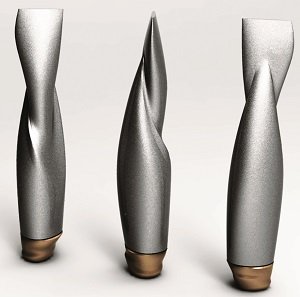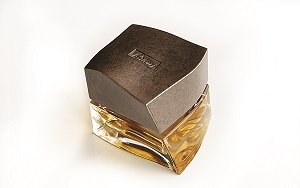
At a shop counter the other day, a young man was asking for body lotion. The shop attendant showed him one or two leading brands. But the young man wanted a brand that he couldn’t remember the name of. Ultimately, to describe the pack, he drew a curvaceous shape in the air with his hands which the shop attendant understood immediately – produ- cing the uniquely ‘body-shaped’ Parachute Advanced Coconut Milk Body Lotion. The packaging for this product is shaped unmistakably to resemble a woman’s torso. In this way, the sculpture sque packaging adds hugely to the brand recall and desirability of the product.
From time immemorial, mankind has been known to have a fascination for art and sculpt- ure. Stone age men painted representations of animals and life around them in their caves. Sculpture found a place in our lives in many different forms. From ancient Egypt or India to Imperial Rome or Greece, royal palace sculpture was used forcefully to assert authority and
power. The religious sculpture of the Vatican had a power of its own. Ancient Indian temples used intricately designed sculpture not only as a design but also as a form of veneration of the almighty. Creatively detailed religious idols were sculptured with a range of materials and have been treated as sacred objects worthy of worship by generations.
The desire for art and fine objects has continued to evolve with civilization. In the late nineteenth century, with Art Nouveau, art was considered a way of life and artists aimed to combine the fine arts with applied arts even for utilitarian, everyday objects of daily life.
During this period, the world of art and business became closely related. This was reflected in the industrial design and advertising of the day. It was inevitable that packaging would also be strongly influenced by the art and sculpture trends of the day.
By applying the aesthetic principles of art, designers quickly discovered that it was possible to design packaging that could surpass ‘mere need and go beyond – to arouse desire.’ Designers know this well and it is for such reasons that many products are intentionally made with ‘sexy’ curves or shapes. For cars, it even goes beyond shape and curves to adding muscle and power.(See PSA July 2012: ‘A Few of my Favourite Things’).
Almost all of us can easily identify with this love for sculptural objects. In our homes, on our desks, on the car dashboard and even in our pockets, we have our favourite perfume bottles (even if empty), a pencil stand, a statuette or a cute keychain. Dressing tables in most homes are often laden with empty packaging that’s simply too good to throw away. Kitchens have re-used favourite tins of tea and confectionery. The prayer niche in homes is decorated with venerated idols and objects.

instead of harsh lines and aggressive communication can create a vital space of its own
What is universal about people and favourite things that packaging designers have learnt to exploit? As French luxury perfumer Majda Bekkali Parfums puts it, “The emotional power of scent extends to encompass visual beauty and tactile pleasure, where artis a form of sensory exploration and product packaging is an integral part of the sensory experience of each fragrance.”
This vital role of art in packaging as a form of tactile and visual experience is even corroborated by Craig Dubitsky, CEO of Hello Products – a line of daily need products like toothpaste, toothbrush and mouth wash. He describes packaging as an art which you can touch. He observes, “The packaging of everyday objects serves as everyday art that is personal, in the sense that you can touch it, which you really can’t do with many pieces of art.” If you can elevate everyday by making it a pleasure to use, then it’s a big win.”
Indeed, packaging that focusses on being ‘easy on the eyes’ and stands out on the shelf for its sculpturesque form instead of harsh lines and aggressive communication can create a vital space of its own. “In an oral-care market dominated by a hand ful of huge companies,” says Dubitsky, “we seek to stand out by our packaging which is softer, artistic and focusses on greeting the customer instead of fighting and killing the competition.” (See:http://www. healthcarepackaging.com/package design/structural/packaging-art-approach-guides-hello-products-oral-care-line)
“The emotional power of scent extends to encompass visual beauty and tactile pleasure, where art is a form of sensory exploration and product packaging an integral part of the sensory experience of each fragrance,” Majda Bekkali Parfums, French luxury perfumer

visualization software has made it easier to visualize and design shapes of increasing complexity, the
same complexity leads to difficulties in mould design and efficient production
However, the leverage that sculptured packs can provide to brand marketing is not often shared by packaging purists. The race to create more artistic packaging often leads to its own difficulties. While sophisticated 3D visualization software has made it easier to visualize and design shapes of increasing complexity, the same complexity leads to difficulties in mould design and efficient production. Production slows down. Rejections increase. Filling line difficulties arise. End-of-line handling automation is affected. Secondary pack design is inefficient. Freight volume increases. In fact, in many cases, even the customer feels cheated when the curves of the pack prevent full use of the product inside.
The Holy Grail in sculpture inspired packaging therefore is to successfully blend sculpture with functionality. The simplicity with which that can be achieved adds to the beauty and appeal of the pack in such a way that it takes on a personality of its own. Such packs stand out from competition. Such packs capture popular imagination. Overtime such packs become iconic.
What does it mean to be iconic?
The Oxford dictionary defines it as ‘to be an icon a person or thing regarded as a symbol of a belief, nation, community, or cultural movement.’ The Bloom-London website(www.bloom -london.com) lucidly lists iconic packaging as having the following five features:
- It is a part of culture – associated with popular memories and nostalgia.
- It is timeless – to have a unique identity and have its own visual vocabulary.
- It dares to change rules – in such a way that it improves our relationship with the object.
- It is fun to use – invites to be picked up and played with.
- It has an idea at its heart – that takes it beneath surface beauty to offer a deeper emotional connect.
Overtime, the world has seen many examples of iconic packaging. Among these, perhaps the one that stands out universally is the bottle of Coca Cola. While it has seen continuous subtle change in shape and size over the decades, its basic iconic sculpturesque form has remained untouched.

Metal Box,to Packaging Developmentin Ranbaxy, Dabur and Oriflame India. Currently, with Firstouch Solutions, a division of Autumn Design, he offers packaging design solutions to a wide range of clients in varied industry sectors. deepackmanchanda@gmail.com; deepakmanchanda.firstouch@gmail.com
It is difficult to think of a similar example of iconic packaging from India though there are several that have attempted to do so. The liquor and perfumery industry are usually the most prolific in creating iconic packs. I have seen many homes in India proudly display bottles of whisky and perfume in show cases. One quirky example, however, that comes to mind of a ‘stand out’ (maybe) iconic pack is the sipper pouch of Paper Boat – the ‘drinks and memories’ from Hector Beverages, Gurgaon.
This comparison between high-end sculptural boutique packs of perfumery and liquor with the everyday pack of a recent beverage brand may sound a little farfetched. However, the battle for shelf-space is drivingmore andmorebrandtowards discarding the boring to seek the bold and beautiful. Everyday products must appeal just as much to all our senses in order to be preferred.
At a recent event in Ambience Mall in Gurgaon, plain unprinted cartons were stacked high to silhouette the skyline of a city. Each carton contained a piece of chocolate. Thousands of cartons were stacked. The art installation sponsored by Maruti Suzuki Dezire was titled ‘One Million Dezires’ to mark the sale of a million Dezire cars.
Everydayplainpackswere theunlikelyprops thatlentthe artinstallationa strange beauty and ironically marked the relationship of packaging and desire in ourlives. Modern design tools and technology is making sculpturesque packs accessible to all categories of products. The art of packaging with care and craftsmanship has moved up to the art of marketing to appeal to more focused cross-sections of customers. Everyday packs have taken on a unique appeal of their own.
It may not be long before a walk down the super market aisle willresemble a walk down an art gallery










